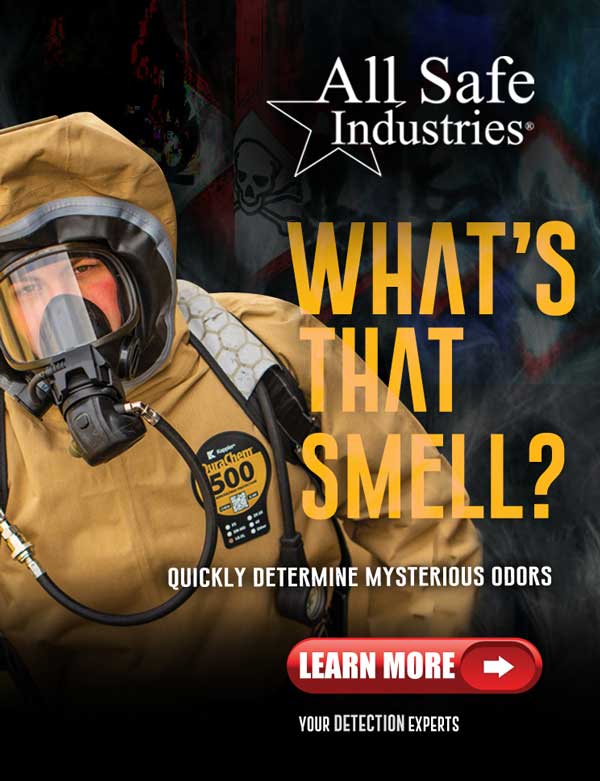By Ron Holcomb
Editor’s Note: Author Ron Holcomb is sharing a chapter from his recently released book Constant Chaos. We’ll feature other chapters in the coming months. Click here for more information on how to get his book.
Part IV Immediately Dangerous to Life & Health
Chapter 16 — “What are we going to do now?”
My co-worker Doug Stolz received an unusual call in January 2016 from a member of the National Guard’s 10th Civil Support Team (CST). He asked Stolz if our spill team had been notified about a situation in University Place about a large stockpile of dangerous chemicals at a residence. Some of the chemicals were possible precursors for home-made explosives. The CST was at the house along with several other local and federal agencies. Stolz told him we weren’t aware of the situation, but he added it sounded like something that we should know about.
The call to Stolz from the 10th CST did not come through normal channels but highlighted the excellent working relationship our team had developed with the specialized federal response team. Stolz, like me, was a senior Hazardous Materials Specialist. Our spill team, along with fire department hazmat teams, had trained regularly with the CST for years. We were familiar with their call-out procedures, so it was highly unusual for them to be mobilized to a chemical incident without us knowing about it. Stolz and I immediately headed to Pierce County to find out what was going on at the residence.
Just as we were pulling up to a roadblock near the house, I got a phone call from a battalion chief with West Pierce Fire & Rescue. Apparently, the fire department hazmat team wasn’t notified of the situation earlier, which was also highly unusual. I told him we’d see him soon.
Stolz and I walked up to a sizeable crowd of emergency responders huddled in a circle in the middle of the blocked-off street. The group included the Pierce County Sheriff’s Department, the Pierce County Bomb Squad, the ATF, the DEA, the FBI and the CST. The group turned in unison toward us as we approached and someone said, “Well what are we going to do now?” Without the slightest hesitation, I said, “Well tell us what we have going on here and we’ll figure it out.”
We learned the homeowner had helped a friend by storing a variety of chemicals in his garage and an outdoor shed. The friend had died several months ago, and the homeowner had become increasingly concerned about the chemicals. He happened to know a local sheriff’s deputy and called him. The deputy responded and then called an acquaintance on the bomb squad. This was not a normal response or notification protocol, and it explained why our spill team and the fire department were not notified earlier in the day.
Extremely Hazardous Substances
We recommended that the CST conduct an entry in chemical suits with air tanks and use their air-monitoring equipment to assess the buildings. The two-person entry team found nothing leaking, or posing a direct, immediate threat. Next, Stolz and I conducted our own assessment to identify the chemicals. We found some highly dangerous ones, including sodium metal and hydrofluoric acid, both classified as extremely hazardous substances. Sodium metal reacts with water creating flammable gases which can burn human tissue and violently ignite spontaneously. Hydrofluoric acid is corrosive to almost everything and can form highly flammable hydrogen gas, creating an explosion hazard. It is also damaging to the respiratory system if inhaled and has the unusual characteristic of penetrating human flesh and attacking the calcium in the bones if it gets on skin.
There were too many chemicals for Stolz and I to pack-up and haul away in our response truck. We advised the sheriff’s department that the residence should remain unoccupied and guarded overnight while we developed a cleanup and disposal plan. Before we left, a Tacoma Police Department (TPD) detective arrived and reported that they had information about a second property tied to the deceased friend of the homeowner. Because the Tacoma property might be a related chemical storage site, the police were getting a search warrant.
I contacted the EPA duty officer while we drove back to the office late that evening. I requested federal help to assess and properly dispose of the chemicals. I got called later in the night confirming that EPA was sending a response team and cleanup contractor in the morning. The TPD detective called me after midnight confirming the search warrant had been served and that a larger chemical stockpile had been found at the second property.
I met the EPA’s Jeff Fowlow and his response team at the University Place residence the following morning along with ATF, FBI and Pierce County Sheriff’s Deputies. Fowlow’s team found more than 200 containers of hazardous chemicals, many improperly stored and labeled. The list of chemicals included compounds of aluminum, ammonium chlorate, barium hydroxide, cadmium nitrate, chromium sulfate, hexamethylenetetramine, lithium, magnesium, potassium chlorate, potassium perchlorate, potassium permanganate, sodium chlorate, sodium cyanide, mercuric nitrate, cesium nitrate, strontium and zinc chloride. By the end of the day, they had collected 242 containers, and had packaged them for disposal.
2012 Incident
Interestingly, Fowlow recognized the name of the deceased person. He recounted a 2012 fire and chemical cleanup in the Tacoma Tideflats where that person had run an internet-chemical-sales operation. The business was run out of a house where he also sold pyrotechnic chemicals for do-it-yourself fireworks kits. In March 2012, a fire started in the one-story wooden house, but the fire department was forced to let it burn because there were so many chemicals. In addition to the house, there were chemicals stored in a box truck and a semi-truck trailer. According to EPA’s report, the fire began when a strong oxidizing chemical spontaneously ignited when it was being repackaged from a bulk container to smaller ones. Thousands of pounds of hazardous substances and wastes were recovered, processed, packaged and transported during the multi-day cleanup. The chemical waste included radioactive materials and explosive compounds.
With that background, I joined Fowlow and the EPA response team to assess the chemical stockpile found by the TPD search. It was up the hill and within a mile of the 2012 incident location. I accompanied EPA, FBI, ATF and TPD to assess the several-acre secluded property. There was an abandoned residence and hundreds, possibly thousands, of chemical containers in four separate buildings. Some of the chemicals were in their original containers and properly labeled. Other chemicals were in buckets or other inadequate and deteriorating containers with hand-written labels. There was evidence of chemicals that had spilled. Running through the property was a stream that flowed down the hill directly into the Hylebos Waterway and Puget Sound.
We spent the day completing the site assessment while EPA mobilized a cleanup team to begin work the following day. It took 10 days for EPA to identify and package more than 9,500 chemical containers. The chemicals included nearly all classes of hazardous materials including flammable liquids, corrosives, oxidizing substances, organic peroxides, toxic substances, spontaneously combustible chemicals, dangerous when wet materials and flammable gases.
Both chemical stockpile sites were ticking time bombs that could have caused large environmental disasters if they hadn’t been cleaned up. The effective cooperation among numerous local, state and federal agencies brought an end to a rogue internet chemical provider.
About the Author

Ron Holcomb worked as a spill responder for the Washington State Department of Ecology before retiring in 2020 after a 40-year public service career dedicated to protecting the environment. He was the Spill Team Lead for Ecology’s Southwest Region and personally handled more than 6,000 oil and hazardous material spill incidents. Prior to being a spill responder, he was a public information officer for Ecology and the Wisconsin Department of Natural Resources. He received a Master of Science in Environmental Communications from the University of Wisconsin after graduating with a degree in Journalism, Biology and Natural Resources from Humboldt State University in Arcata, Calif. He developed his love of the outdoors and concern for the environment during childhood experiences in national parks and forests, and as a member of The Mountaineers. In retirement he still enjoys climbing peaks in the Olympic and Cascade Mountains.



